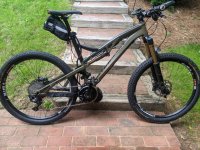MoneyPit
10 W
geosped said:I've also been charging the pack to 90% not 100% I've heard this is supposed to prolong the life of the pack and every 5th charge or so I'll go to 100%. I think that is supposed to balance charge the pack. What I don't understand is got the pack down to 11% still read 48v. It's a bit off though my multi meter is reading 48.4v. I've heard keep it above 44v and I should be safe. The vendor said BMS is set to 41v that sounds really low. I wish the EggRider had some sort of audible alarm that's adjustable. So im not really sure where im at other than just continue to monitor the voltage and don't go below 44v?? Or is there something else I should be doing.
Not charging to full capacity does prolong battery life. The usual recommendation is 80%. And even though the info about not charging to full capacity has been out there... forever... still its not widely recognized by consumers. So thats why, I think, you don't hear much about depth of discharge, which is just as bad or worse depending on who you ask.
Scroll down to Table 2:
https://batteryuniversity.com/article/bu-808-how-to-prolong-lithium-based-batteries
A li-ion battery is happiest over the long term if you keep it roughly between 80% and 40%. Roughly. What this means is its better to have a battery thats bigger than you need than it is to carry two of them and drain the bejesus out of them.
With that said, enjoy your bike. Yeah what you are doing may kill the pack sooner, but you could swallow a chicken bone at dinner tonight and thats the end of you. Do what you can within your limits of convenience.
As for battery voltage, they are called '48v' but max charge on such a pack is 54.6v. Here check out these charts and you can see where your 44v and 41v are on the scale.
https://talesontwowheels.com/2019/10/02/li-ion-ebike-battery-charge-charts/
As for balancing, I ride every day and charge to 80% at work in the morning and at home in the evening. Once a month, I do a 100% charge to balance the pack. If I rode less I could do it less frequently. Even what I am doing is just guesswork though. Its not like I am measuring each bank of cells to see if one has gone wonky.



